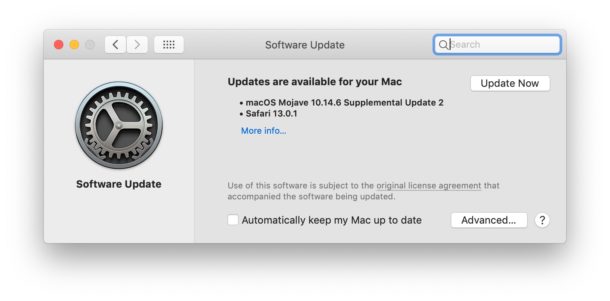MacOS Mojave 10.14.6 Supplemental Update 2 Released

Apple has released macOS Mojave 10.14.6 Supplemental Update 2 for Mac users running the Mojave operating system.
The new supplemental update is said to improve the security of MacOS and is therefore recommended to all users who are running MacOS Mojave.
Apple has also released Security Update 2019-005 for macOS High Sierra and Security Update for macOS Sierra for Mac users running prior system software releases. Additionally, iOS 12.4.2 is available for older iPhone and iPad models, and watchOS 5.3.2 is available for older Apple Watch models.
Installing macOS Mojave 10.14.6 Supplemental Update 2
The simplest way to update MacOS Mojave 10.14.6 supplemental update 2 is by backing up the Mac to Time Machine and then installing the macOS software update through System Preferences as so:
- Pull down the Apple menu and choose “System Preferences” then go to “Software Update”
- Choose to “Update Now” when you see “macOS Mojave 10.14.6 Supplemental Update 2” available as an update

If you have other software updates waiting, recall that you can selectively install specific macOS updates and avoid others (for example, if you don’t want to install Safari 13 for some reason).
If you’re running an earlier version of macOS then you will instead find Security Update 2019-005 for macOS High Sierra and Security Update for macOS Sierra available as system software updates.
Users can also choose to download the macOS Mojave 10.14.6 Supplemental Update 2 or the Security Update package installers directly from Apple:
- macOS Mojave 10.14.6 Supplemental Update 2 (build 18G103)
- Security Update 2019-005 for macOS High Sierra
- Security Update 2019-005 for MacOS Sierra
If this update sounds a little like deja vu, it’s likely because there have been several other supplemental updates released for MacOS 10.14.6. Despite being labeled as “macOS Mojave 10.14.6 Supplemental Update 2”, technically speaking, this is actually the third supplemental update to macOS 10.14.6 with build 18G103 after the second (build 18G95) was released with the same name to replace the first supplemental update (admittedly a little confusing, but that’s how it has played out).
Release notes accompanying then download for “macOS Mojave 10.14.6 Supplemental Update 2” are brief as follows:
macOS Mojave 10.14.6 Supplemental Update 2 –– Restart Required
macOS Mojave 10.14.6 Supplemental Update 2 is recommended for all users and improves the security of macOS.
For more detailed information about this update, please visit: https://support.apple.com/kb/HT209149For detailed information about the security content of this update, please visit: https://support.apple.com/kb/HT201222
Separately, Apple has also released iOS 12.4.2 for iPhone and iPad devices that were dropped by iOS 13 and later, otherwise iOS 13.1 and iPadOS 13.1 are the latest software releases for newer iPhone and iPad.
Older Apple Watch Series 1 and Series 2 also will find watchOS 5.3.2 available as an update.


Just in case someone is wondering SDL 1.2 applications still crashing the WindowServer when the where are closed and the app was in full screen mode before. I assume the mapping from OpenGL (used by SDL 1.2) to Metal (used by CodeDisplay) is not working correct.
Last time SDL apps working fine was with 10.14.5 but since 10.14.6 and also with the now three supplemental updates nobody in Cupertino seems to care anymore that OpenGL is no longer fully working as before. :-(
This supplemental update killed the connection with my monitor. Have to unplug and replug the HDMIcable after every shutdown.
Did you find a fix yet ? Asking coz I’m facing the same problem.
ALL of the ‘supplemental updates’ will only install on macOS 10.13.6 systems that are on APFS formatted discs… they won’t install if your drive is formatted HFS+.
Not quite sure why Apple has done this…? Anyone have an explanation?
I don’t know why under Mojave, but Catalina won’t even begin to boot if its been copied onto an HFS+ partition. Even time machine won’t restore backups properly from the HFS+ partition they are required to be stored on.
My guess would be that its been done to keep macs with older firmware and software from running the newer OS’s
I know my older macs don’t show boot sources with APFS partitions.
As it’s happened with the last two Mojave updates, the macOS Mojave 10.14.6 Supplemental Update 2 (build 18G103) downloaded at office (where connection’s good) and applied at home on my Mac (twice) still get my Mac asking me to download the software update (approx. 4 hours for the 1,25 Gb file)…
Updating Mac’s become a nightmare
All this update did for me was re-enable SIP and Gatekeeper. I also had to re-enable auto-login.
AND Killed my bluetooth speakers . Not Happy
Links to the individual Apple update files do not work, just link back to this article.
They’ll be available on https://support.apple.com/downloads/macos
But direct links are